Introduction: In this article Gena Philibert-Ortega describes the Boston Molasses Disaster that occurred on this date in 1919, resulting in almost 200 casualties. Gena is a genealogist and author of the book “From the Family Kitchen.”
Imagine a flood that originates from a large tank spilling 2.3 million gallons weighing 12,000 metric tons. (1) A flood disaster that causes damage to homes and buildings, kills 21 people and injures 150. The damage from the explosive flood is so massive that it is still visible over 100 years later. Theories abound about the cause of the flood, including the possibility of Italian anarchists throwing bombs to ignite explosive gases.
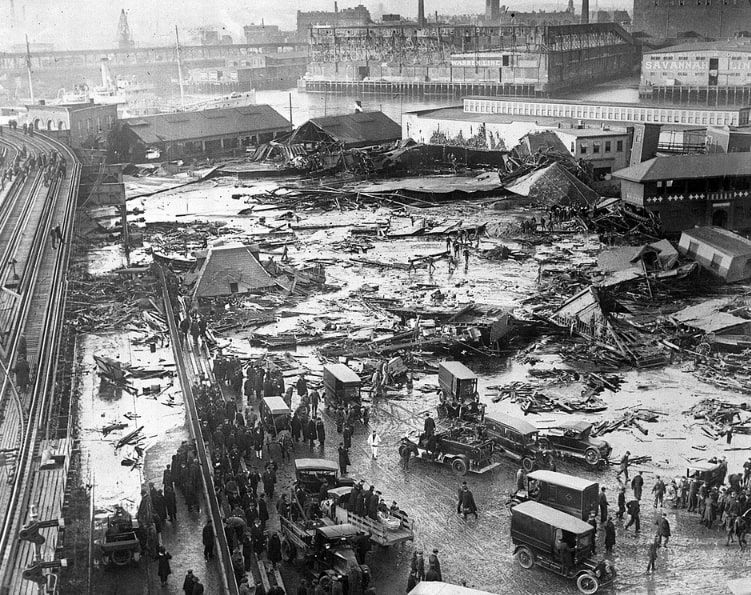
This flood disaster of 1919 is even more unbelievable because it’s not a flood of water that causes the damage: it’s molasses, and it really happened!
Molasses?
Before diving into the facts of the Boston Molasses Flood of 1919, let’s discuss what molasses is. Molasses is the residue product of refining sugarcane or sugar beet juice into sugar. It is used to sweeten foods, is an ingredient in brown sugar, and used to distill rum. (2) It was also used in ammunition during World War I. (3)
So, now that you know what it is and understand its uses are greater than just something to add to baked goods, you might be wondering: why did Boston have a large tank of molasses in their port? Why was that necessary?
The tank was owned by U.S. Industrial Alcohol Company and, like their name implies, they were an alcohol distiller. The importance of molasses and its storage in Boston is a longer historical story, but at this point in time the molasses stored in that tank was used to make alcohol. The molasses was shipped into the port and added to the tank. Later it would be drained and transported by rail.
The tank was described in the Boston Herald as:
58 feet high, in appearance similar to a big gas tank, [and] stood a few feet back from Commercial Street, almost opposite Copps Hill Park. Along its northerly side, extending from Commercial Street to the waterfront, ran the platform and sheds of the Boston & Worchester and Boston Elevated Railway Companies.
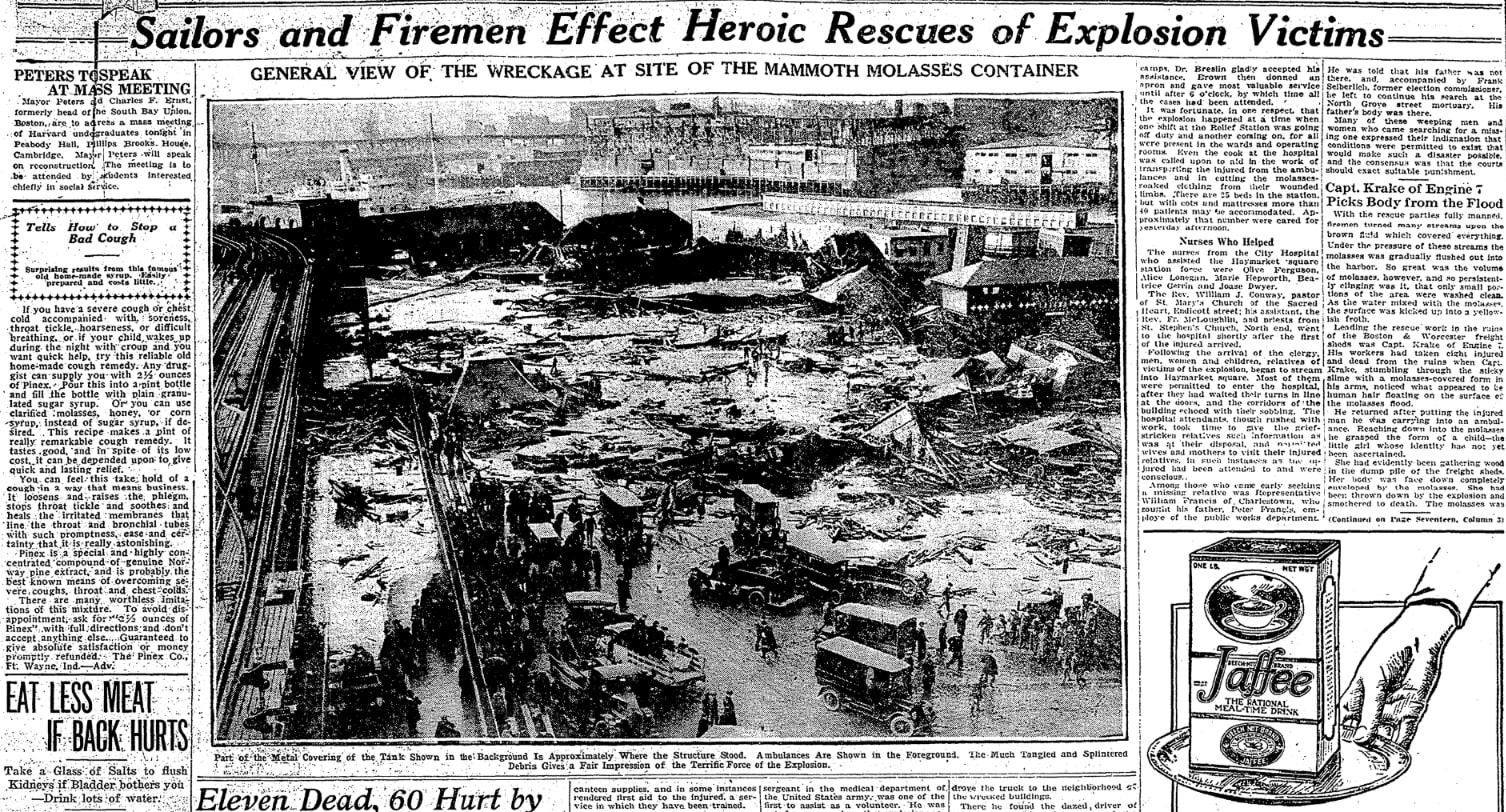
The photo caption reads:
Part of the metal covering of the tank shown in the background is approximately where the structure stood. Ambulances are shown in the foreground. The much tangled and splintered debris gives a fair impression of the terrific force of the explosion.
This article reported the moment the giant molasses tank exploded:
A muffled roar burst suddenly upon the air. Mingled with the roar was the clangor of steel against steel and the crash of rending wood.
The roar and din were momentary. Spurting high into the air and in far-reaching spread were great ribbons of thick brown fluid. The huge, tossing geyser of molasses settled to be-plaster the outer walls of the neighborhood outside the destroying force of the explosion, to sink into big pools on the flat roofs and to inundate in an adhesive flood the streets, alleys and debris.
The fury of the explosion tore the big tank plate from plate. The outward propulsion was followed instantaneously by a tremendous vacuum, which sucked into ruin structures which had withstood the primary blast.
The Molasses Explosion
The giant tank in question had problems before the flood disaster. It was known to leak sweet molasses that the local children would eat. The U.S. Alcohol Company knew the leak was happening but chose to ignore it. On 15 January 1919 at approximately 12:30 pm, they could ignore it no longer.
It is hard to understand how a tankful of molasses might do any harm. After all, unlike water, it is thick and a slow pore. But on that day over two million gallons of the sticky thick liquid spilled out and rushed through the streets of Boston. It has been described as a 35-mile-per-hour tsunami wave. (4) While that may be hard to understand if you’ve ever poured molasses out of a bottle, the way that the molasses spilled, more like a lava flow than a pore from a jar, made it incredibly fast. (5)
Now consider that this fast-flowing molasses was like a tidal wave through town. An Omaha, Nebraska, newspaper described the moments at the beginning of the disaster.
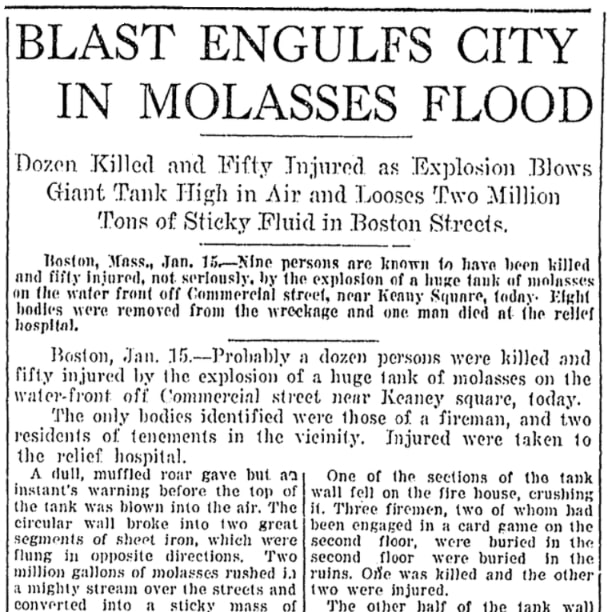
This article reported:
A dull, muffled roar gave but an instant’s warning before the top of the tank was blown into the air. The circular wall broke into two great segments of sheet iron, which were flung in opposite directions. Two million gallons of molasses rushed in a mighty stream over the streets and converted into a sticky mass of wreckage of several small buildings which had been smashed by the force of the explosion.
The flood destroyed buildings and swept up people as they walked. The nature of molasses meant that people and animals were “stuck” and in some cases drowned in the brown, heavy liquid. After the flood, the streets, buildings, and homes inside and out were sticky, making movement, rescue efforts, and cleanup difficult at best.
A total of 21 people died and 150 people were injured from the flood, plus 12 horses and an unknown number of cats and dogs also perished. (6) Local groups came to the aid of the victims and survivors. Firefighters tried to “push” the molasses with water back into the bay. The Women’s Volunteer Motor Corps transported patients to the hospital and offered first aid. Women served hot coffee to victims and rescuers. Sailors from the USS Nantucket, moored at the North End Pier, helped in the rescue efforts. (7)
A Molasses Explosion?
The Molasses Flood of 1919 was described as an explosion in early reports, and finding the cause of this explosion was a local priority. Early reports debated the fermentation of the molasses as a cause of the explosion, while other reports raised the possibility of a bomb.
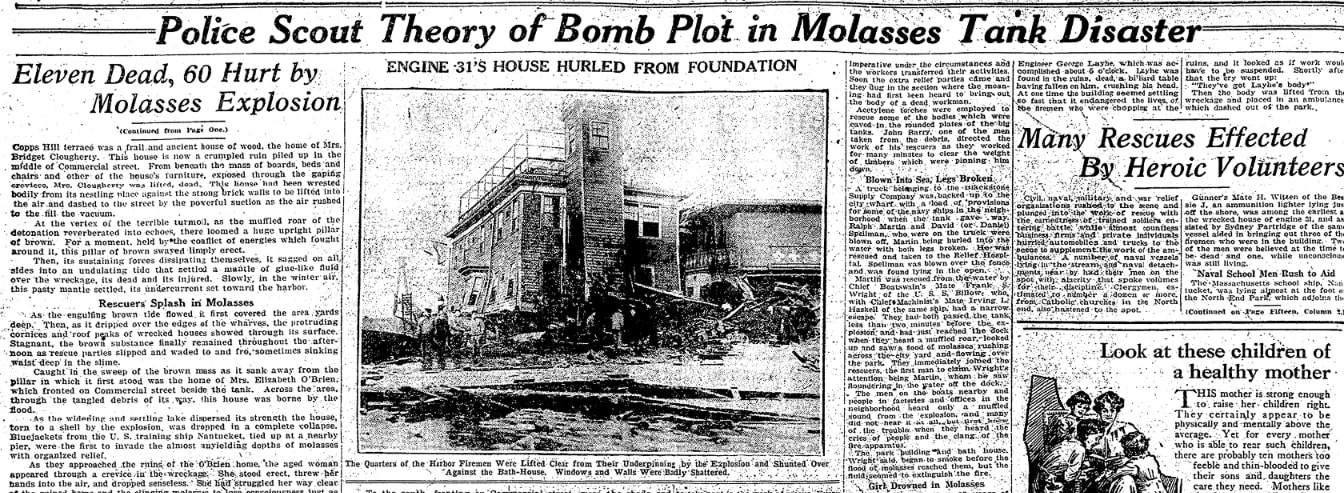
This article reported:
That the explosion came from powerful gases generated within the tank by the fermentation of the molasses was an early surmise. There was expert opinion last night, however, to discredit this theory. One expert asserted that the power of molasses to ferment explosive gases is practically negligible.
In the conjecture as to the explanation also appears the surmise of a bomb plot. The police are giving some attention to this theory, but evidence on the scene is yet unavailable. The site of the tank is a molasses flood dotted with the wreckage.
This next article reported that gases within the molasses tank were the cause of the explosion.
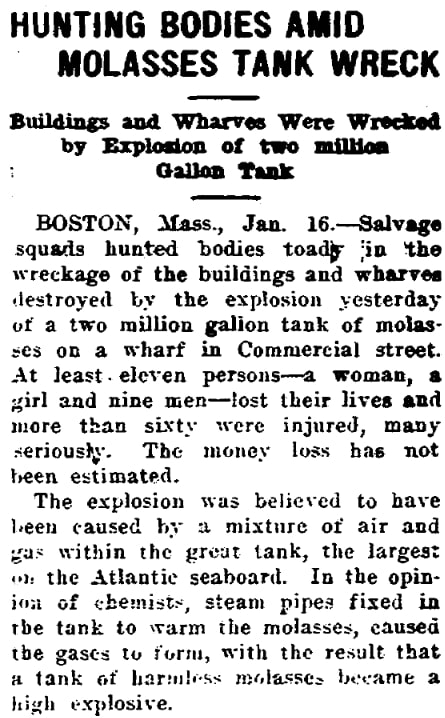
This article reported:
The explosion was believed to have been caused by a mixture of air and gas within the great tank, the largest on the Atlantic seaboard. In the opinion of chemists, steam pipes fixed in the tank to warm the molasses caused the gases to form, with the result that a tank of harmless molasses became a high explosive.
So, what really happened? A more modern analysis in 2014 concluded that the tank’s steel walls were too thin to support the weight of a full tank of molasses. In addition, a flawed rivet design contributed to the failure of the tank. (8)
Eventually U.S. Industrial Alcohol was charged with maintaining an unsafe structure and they were the defendant in approximately 125 lawsuits placing responsibility on them for deaths, injury and property destruction. (9)
This October 1919 newspaper article reported that a motion had been filed to “have the suits arising out of the collapse of the molasses tank… sent to an auditor to determine liability and damages.”
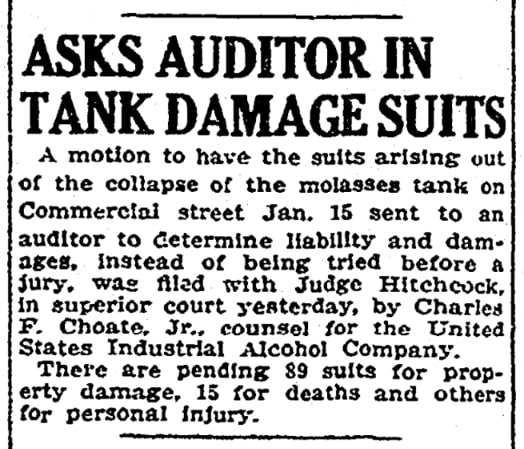
Eventually it was reported that they paid over $1 million in damages.
Visiting the Site
If you’re interested in learning more about the Boston Molasses Flood of 1919, I recommend that you start with searching GenealogyBank’s Historical Newspaper Archives.
First, search on the word “Molasses” (in the “Include these keywords” box). Once you receive your results, narrow your search by the year 1919. That will help you focus your results on the flood and other articles mentioning molasses. Also, keep in mind that you can narrow your results by state – in this case Massachusetts – but this was a big news story and articles can be found in newspapers nationwide.
If you’re interested in reading a longer treatment of the disaster, a history of the flood was written by Stephen Puleo titled Dark Tide: The Great Boston Molasses Flood of 1919.
If you want to visit the area of the flood on your next trip to Boston, a plaque about the disaster can be found on Boston’s North End Freedom Trail behind Copp’s Burying Ground. For more information see the Boston Discovery Guides.
Explore over 330 years of newspapers and historical records in GenealogyBank. Discover your family story! Start a 7-Day Free Trial
Note on the header image: damage to the Boston Elevated Railway caused by the burst molasses tank and resulting flood in 1919. Credit: Wikimedia Commons.
____________________
(1) “Great Molasses Flood ,” Wikipedia (https://en.wikipedia.org/wiki/Great_Molasses_Flood: accessed 3 January 2024).
(2) “Molasses,” Wikipedia (https://en.wikipedia.org/wiki/Molasses: accessed 3 January 2024).
(3) “The Great Molasses Flood” Boston Discovery Guide (https://www.boston-discovery-guide.com/great-molasses-flood.html: accessed 8 January 2023).
(4) “Why the Great Molasses Flood Was So Deadly,” History (https://www.history.com/news/great-molasses-flood-science: accessed 8 January 2024).
(5) Ibid.
(6) “The Great Molasses Flood,” Boston Discovery Guide (https://www.boston-discovery-guide.com/great-molasses-flood.html: accessed 8 January 2024).
(7) “A Sticky Situation: The Navy and the Great Molasses Flood,” The Sextant (https://usnhistory.navylive.dodlive.mil/Recent/Article-View/Article/2686883/a-sticky-situation-the-navy-and-the-great-molasses-flood/#:~:text=World%20War%20I%20had%20broken,produce%20industrial%20alcohol%20for%20munitions.: accessed 8 January 2024).
(8) “Why the Great Molasses Flood was so Deadly,” History (https://www.history.com/news/great-molasses-flood-science: accessed 8 January 2024).
(9) “United States Industrial Alcohol Company,” Wikipedia (https://en.wikipedia.org/wiki/United_States_Industrial_Alcohol_Company: accessed 8 January 2023).
